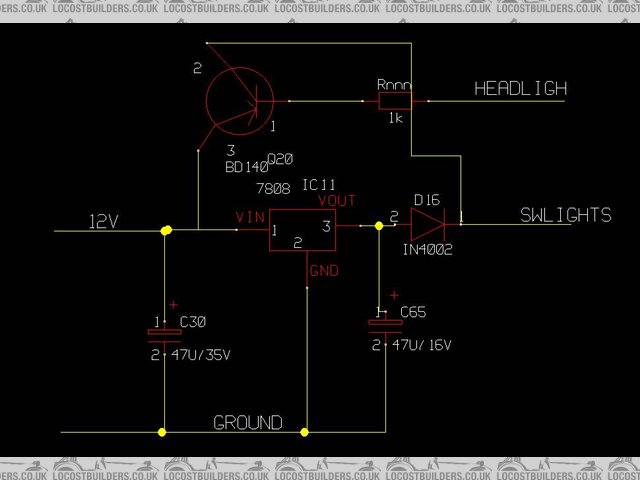

Circuit
Darren
[Edited on 3/12/09 by turbodisplay]

what im trying to do is iluminate all the tell tail lights in the durite switches dimly for night driving so that I can find the switches in the dark.
I would also like the switch tell tails to still iluminate fully when activated as they do now.
each 1.2w bulb has an earth wire and a live feed from the switch when pressed for the tell tail so figured i need a lower voltage feed into each tell
tail bulb when the headlights are turned on.
Whats the best way to drop the voltage to 8 or so tell tail bulbs at 1.2w each, I was thinking a potential divider but what rating resistors would I
need. or is there a better way to drop the voltage?
I think there is a bit of kit designed just for the job but cant remember its name, have tryed searching but can't find the post Im after,
help!
Many thanks in advance for your advice
Varible voltage regulator lm317, or the high voltage version lm317hv.
or use a 8v voltage regulator 7808.
Will need to be mounted to a heatsink if more than 0.3 - 0.4A flows through it.
You will need 2 capacitors to make the circuit work (7808) or 2 capacitors and 2 resistors (317)
Darren
You could use a 9v regulator such as this one from Maplin. To stop all of the lights
illuminating when you pushed the button you would need a diode between each switch bulb and the regulator. IN4001s to IN4005s should do.
You should be able to power several lights off a single regulator.
ETA - beaten to it. I thought 9v as the diode will drop 0.6v so the supply would be 8.4. The adjustable reg could be good as the voltage could be
tweaked to get the brightness wanted.
[Edited on 2/12/09 by Toltec]
you want to reduce the power to the lamps, this can be achied by:
1. reducing the voltage - as ^^^ by introducing a drop resistor or voltage regulator
2. modulating the voltage i.e. pulsing the supply
1. has disadvantage that you are going to have to dissipate heat hence the need for a larger resistor or heatsink if done electronically. the drop
reisitor is the simplest and you can fit a variable wirewound resistor to vay the brightness, likewise with a variable voltage regulator.
2. this is a more power efficient way.
depending on how many bulbs you have, you will need to disspiate a few watts - guesing at least 5 W - so that is a quite expensive variable resistor
or cheaper if using fixed value resistors.
if you fit LED bulbs, the resistor (variable or fixed) it will be cheaper but be offset by price of bulbs.
[Edited on 3/12/09 by 02GF74]
This circuit will give 12V when the lights are off, 7.4V when the lights are on.


Circuit
Darren
[Edited on 3/12/09 by turbodisplay]